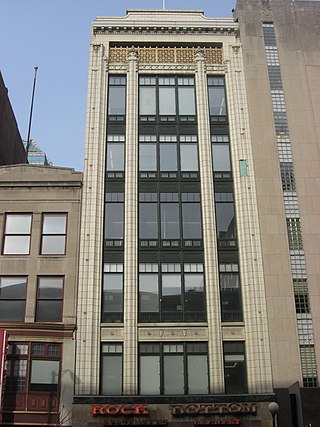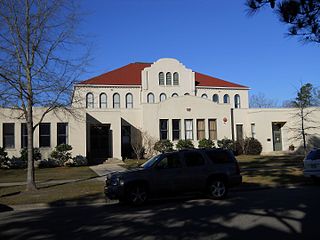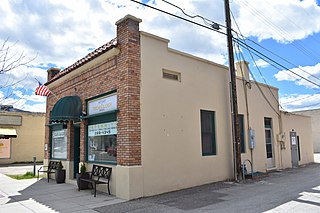
The Alms and Doepke Dry Goods Company is a historic commercial building in Cincinnati, Ohio, United States. Located along Central Parkway on the edge of downtown, it is a late Victorian structure designed by Samuel Hannaford, a renowned Cincinnati architect.

The Farm House, also known as the Knapp–Wilson House, is the oldest building on the campus of Iowa State University in Ames, Iowa. Now a museum open to the general public, this house was built 1861-65 as part of the model farm that eventually became Iowa State. It was designated a National Historic Landmark in 1964 for its association with agriculturist and teacher Seaman A. Knapp and with U.S. Secretary of Agriculture James Wilson, both of whom lived here while teaching at Iowa State.

The Patton and Loomis Block is a historic commercial block at 1628-40 Main Street in downtown Springfield, Massachusetts, United States. Built in 1864 and remodeled in 1909, it is a good example of commercial architecture built or updated during two of the city's boom periods, in this case by two of the city's major developers. The block was listed on the National Register of Historic Places in 1983.

The Jose V. Toledo Federal Building and United States Courthouse is a historic post office and courthouse located at Old San Juan, Puerto Rico. It is a courthouse for the United States District Court for the District of Puerto Rico. It is also the site for oral argument before the United States Court of Appeals for the First Circuit, when that court sits in Puerto Rico.

The Joseph Jossen House, also known as the World Trade Building, is a historic house in Mobile, Alabama, United States. The 2+1⁄2-story, brick, Queen Anne–style structure was built in 1906 for Joseph Jossen. Jossen was the local agent for the F.W. Cook Brewing Company, a beer brewing company based out of Evansville, Indiana. The Mobile distribution branch was established by him at 19 South Commerce Street in 1884. Additionally, Jossen was involved in the general liquor trade. In later years the house was adapted for reuse as the local international trade center. During this period the front porch was infilled and a two-story stuccoed addition was added to the rear elevation. As of 2009, the building was occupied by a title insurance company. It was added to the National Register of Historic Places on May 29, 1992.

Central Office Building is a historic building located in downtown Davenport, Iowa, United States. It has been individually listed on the National Register of Historic Places since 1983. In 2020 it was included as a contributing property in the Davenport Downtown Commercial Historic District. It is located in the center of a block with other historic structures. It now houses loft apartments.

The E.P. Adler House is a historic building located in the central part of Davenport, Iowa, United States. It has been individually listed on the National Register of Historic Places since 1983. In 1984 it was included as a contributing property in the Vander Veer Park Historic District. It has been on the Davenport Register of Historic Properties since 2008.

The Nathaniel West Buildings in southeast Portland, Oregon, United States, are listed on the National Register of Historic Places. The two structures are part of a group of three, including West's Block, built by West in the late 19th century.

The Baker-Devotie-Hollingsworth Block is an historic building located in the East Village of Des Moines, Iowa, United States. The eastern two-thirds of the block was listed on the National Register of Historic Places in 1978 as the Studio Building. The western one-third was added to the National Register in 2008, and its name was changed at that time. In 2019 the entire building was included as a contributing property in the East Des Moines Commercial Historic District.

The National Biscuit Company Building, also known as National Biscuit Company Flats, is an historic building located in downtown Des Moines, Iowa, United States. The heavy timber and masonry building was built in 1906. Only half of the planned building was completed, and the north half of the property was later sold. It initially served as a production and distribution facility for the National Biscuit Company. Architect William F. Wilmouth, who designed the company's buildings is presumed to be the architect of this four-story Neoclassical building. Benson & Marxer served as the contractors. Des Moines was the third largest sales territory for the company. It was one of a few bakeries in the company that produced the Uneeda Biscuit, and it was one of three that produced a corn cracker in the mid-1920s.

Main Office of the New Castle Leather Company, also known as The Main Office of the Allied Kid Company from 1933 to 1977, is a historic office building located at Wilmington, New Castle County, Delaware. It was built in 1917, and is a three-story, steel frame stuccoed brick building in the Mission Revival Style. The building measures 68 feet wide and 30 feet deep. It features a revolving door and curved granite steps at the main entrance, red Mission style tiles on the mansard, and large decorative iron bars and grill work on the first floor windows.

The Iowana Hotel, now known simply as The Iowana, is a historic building located in Creston, Iowa, United States. Because Creston was on the mainline of the Chicago, Burlington and Quincy Railroad, and it was a divisional headquarters, it received a steady flow of visitors. Hotels that featured fireproof construction and modern amenities, such as this one, started to enter Iowa's secondary markets in the 1910s and 1920s. A group of local businessmen formed the Hotel Investment Company, and built the hotel. They hired the Chicago architectural firm H.L. Stevens & Company, known for its hotels, to design and build the Iowana. The building was constructed from 1919 to 1920. It served as Creston's primary hotel until about 1958 when more convenient and economical motels were built along the highway. By this time rail travel was declining and highway travel was increasing. The Hotel Investment Company sold the building in 1971. It continued in operation under various owners into the 1980s. The building was listed on the National Register of Historic Places in 2009. It stood vacant for several years until it was transformed into an apartment building.

Manchester Apartments is a historic apartment building in Indianapolis, Indiana. It was built in 1929, and is a three-story, Tudor Revival style brick building. It measures 40 feet wide and 210 feet long and features a gable front pavilion with stucco and decorative half-timbering. The building was remodeled in 1971. It is next to the Sheffield Inn.

Selig's Dry Goods Company Building, also known as Morrisons/Em-roe Sporting Goods Company, is a historic commercial building located at Indianapolis, Indiana. It was built in 1924, and is a seven-story, rectangular, Beaux-Arts style building with a white terra cotta and aluminum front facade. It was remodeled in 1933. The building features tinted plate glass windows and a terra cotta Roman thermal window-like screen at the top floor. The building housed the Selig's Dry Goods Company, in operation until 1933.

The Charles Walter Hart House is a historic building located in Charles City, Iowa, United States. It was listed on the National Register of Historic Places in 1980. The hollow clay tile structure completed in 1914 is faced with rockfaced granite on the basement level, brick on the first floor, and stucco-half-timberwork on the gable ends. The Bungalow combines elements of the American Craftsman and Prairie School styles.

The Motor Mart Building, also known as the Commerce Building, is a historic building located in Sioux City, Iowa, United States. It was built by Ralph A. Bennett, who was the owner of Bennett Auto Supply Company. The structure was designed in the style of the Chicago school by E.J. Henriques of the C.F. Lytle Company of Sioux City, who also built the structure. It was initially designed to be two stories tall, but the plans were changed and two more floors were added. It was designed to display, repair and provide parking for automobiles. It was also the first building in Sioux City to incorporate the flat slab system of framing of Claude A.P. Turner, and it was one of the first reinforced, poured concrete buildings in the city. The exterior of the concrete frame structure is clad with glazed brick over common brick infill. The building features terra cotta decorative elements.

Walthall School, also known as Court Street School, is located at 601 Court Street in Hattiesburg, Mississippi. It was utilized as a public school building from 1902 until 1987. The building is a contributing property to the Hattiesburg Historic Neighborhood District, which was placed on the National Register of Historic Places in 1980. The building was designated a Mississippi Landmark in 1988.

The Ralph Rollins House, also known as the Bohen Estate, is a historic building located in Des Moines, Iowa, United States. This rambling mansion in the English medieval eclectic style was designed in 1925 by the Des Moines architectural firm of Boyd & Moore. It was completed the following year. The facades are a picturesque accumulation of gables, window bays, over hangs and minor projections. The roofscape is significant in defining the character of the house. Its main ridge runs the length of the structure, and it features short cross gables. The walls are a combination of brick and stucco half-timber in almost equal proportions. Together with Salisbury House, it is unique in Des Moines, and probably the state, for literally borrowing from England's domestic medieval architecture. The house was listed on the National Register of Historic Places in 1978.

The Des Moines Western Railway Freight House, also known as the Des Moines, Iowa Falls & Northern Railroad Freight House, is a historic building located in Des Moines, Iowa, United States. Built between 1902 and 1903 by local contractor William H. Brererton, this two-story brick building features a low-pitched, side gable roof. It was built as a railroad freight house for F.M. Hubbell and the Des Moines Western Railway, which was an attempt to link the city and points west, but it never made it beyond the city limits. It is now a rare example of a once common building type in the city. The building was leased to the Des Moines, Iowa Falls, and Northern Railroad (DMIF&N), another Hubbell venture. An interurban line, the Fort Dodge, Des Moines & Southern Railroad (FtDDM&S), acquired the DMIF&N and continued to use this freight house for that purpose as they carried a high volume of freight. The building has been remodeled three times. The first was when part of it was converted by the FtDDM&S into an interurban passenger depot in 1933. The second time was when it was converted into a restaurant in the 1980s. The third time was its conversion into an office building, which is what it is today. The building was listed on the National Register of Historic Places in 2008.

The Mountain States Telephone and Telegraph Company Building in Meridian, Idaho, is a 1-story commercial office constructed of reinforced concrete, stucco, and brick in 1928. The building features a short, modest tile roof above its Main Street entrance, indicating a Spanish Revival design influence. The Main Street exposure is clad with brick veneer, and above the entrance is a corbelled brick frieze band. A masonry garage was added at the rear of the building in 1948. The garage was remodeled in 1998.























